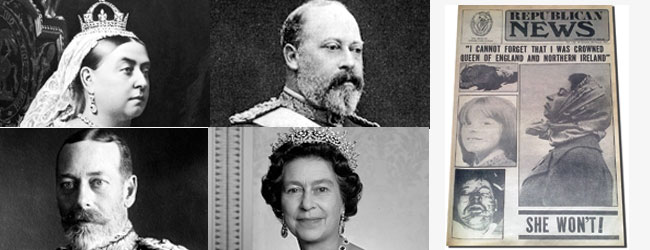14 April 2011
Remembering the Past
Unwelcome visitors – British monarchs in Ireland
“We confess to having more respect and honour for the raggedest child of the poorest labourer in Ireland today than for any, even the most virtuous descendant of the long array of murderers, adulterers and madmen who have sat upon the throne of England” – James Connolly, 1897
WITH the Queen of England due in May to make the first official state visit by a British monarch to the 26 Counties since partition, Remembering the Past looks at the history of such visits.
BEFORE the 19th century, British royal visits to Ireland were extremely rare and had one purpose - the few who came led armies of conquest or reconquest. It was only in the middle of the 19th century that visits by British monarchs began to take on their modern propaganda purpose.
1849“A tonic for trade” was how the purpose of Queen Victoria’s first visit here was described, a description that displayed contempt for Ireland. The country was then in ruins. Over a million people had died of starvation and disease, evictions were a daily occurrence and a further million were emigrating in the wake of the Great Hunger.
Despite the failure of the Young Ireland rebellion the year before, there were still enough militant nationalists in Dublin to plan to kidnap Victoria. Two hundred assembled to make the attempt but they had to disperse due to the overwhelming numbers of British troops. The ‘Famine Queen’ returned in 1853 and 1861.
1897 This year marked Victoria’s ‘diamond jubilee’ and the British garrison in Ireland staged events designed to impress the natives with the power of the British Empire, then at its height.
A member of the royal family, the Duke of York, was dispatched to Dublin where he was met with demonstrations. On two successive nights in June, James Connolly and Maud Gonne led protests of thousands of people who were baton-charged by the police. A coffin marked ‘British Empire’ was thrown into the Liffey during a mass demontration. When Maud Gonne staged a magic lantern display in Parnell Square, the crowd was again batoned and an old woman was killed. Connolly wrote of the ‘Jubilee’:
“During this glorious reign, Ireland has seen 1,225,000 of her children die of famine, starved to death while the produce of her soil and their labour was eaten up by a vulture aristocracy, enforcing their rents by the bayonets of a hired assassin army in the pay of the ‘best of English queens’.”
1900 The visit of Victoria to Dublin in this year was part of the recruiting campaign for the British Army, which was then fighting in the Boer War in South Africa.
The Duke of York was first sent to test the waters but the visit cost the Lord Mayor his coach when it was destroyed by protesters.
When the queen arrived later, she used the occasion to formally establish the Irish Guards regiment of the British Army. The royalists organised a free ‘treat’ for children but even this came unstuck when Maud Gonne put on an alternative ‘Patriotic Children’s Treat’ which was given to 20,000 youngsters in Dublin.
1903 When Edward VII visited Dublin, such was nationalist opposition that Dublin Corporation refused to present an address of welcome. Even William Martin Murphy, the ruthless employers’ leader of the 1913 Lock-Out, had to refuse a knighthood from the king.
1911 The United Nationalist Societies was formed to oppose the visit of George V.
Again, Dublin Corporation was successfully lobbied to refuse an address of welcome. Constance Markievicz and Michael O’Rahilly had a large banner erected at the bottom of Grafton Street in the guise of a loyal display but when unfurled it read: “Thou art not conquered yet, dear land.”
Demonstrations were held to coincide with the visit itself and the coronation. The day the king arrived here, republicans assembled for the first large-scale commemoration at Wolfe Tone’s grave in Bodenstown. Republican and feminist Helena Moloney was imprisoned after she smashed a window displaying a portrait of George V.
1921 George V’s speech in Belfast City Hall has often been described as conciliatory but the occasion was his opening of the first Orange parliament, established under the Government of Ireland Act the year before. In his name, severe repression was imposed to consolidate partition and the Six-County state with pogroms, assassinations and mass internment without trial.
1977 By far the most politically-charged visit was that of the present English queen to the Six Counties in 1977.
This was the pet project of notorious British Labour Party Direct Ruler Roy Mason. He presided over severe repression in the prisons and on the streets as he sought to criminalise the republican struggle. Mason boasted that he was squeezing the IRA “like a tube of toothpaste”.
In advance of the visit there were hundreds of dawn raids across the North by the RUC and British Army and people were held under seven-day detention orders to try to disrupt protests - 33,000 members of the crown forces were fully mobilised.
Mason’s plans were foiled. The IRA obtained the top-secret itinerary of the visit. A bomb was planted in the grounds of Coleraine University and a warning given. The queen’s visit to the campus went ahead but the bomb was not a hoax. It exploded some hours after her visit, breaching the tightest of security and embarrassing Mason in his moment of glory.
Twenty thousand people took part in a march from west Belfast to the city centre. They were blocked by a ring of steel and the British Army and RUC opened up on the crowd with lead and plastic bullets, batons and rifle butts.
Follow us on Facebook
An Phoblacht on Twitter
Uncomfortable Conversations

An initiative for dialogue
for reconciliation
— — — — — — —
Contributions from key figures in the churches, academia and wider civic society as well as senior republican figures





